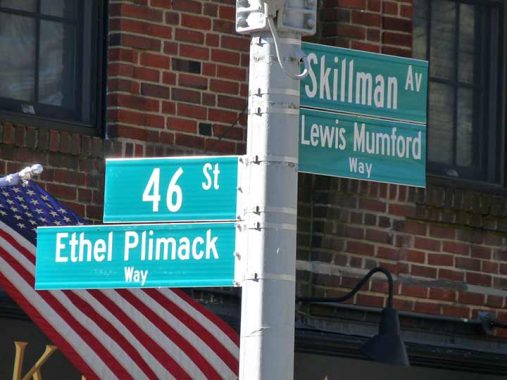
I’LL admit it. I’d like to get my name on an honorific New York City street sign. However, if I do I’ll never be able to see it because the city bestows this honor only after the honoree is deceased. (Frankly I think I rate such a sign because of my now quarter century’s worth of efforts chronicling Forgotten New York, but I’ll have to leave that to my successors. If any.)
Meanwhile, here’s a pair of honorific signs in Sunnyside, Queens. Ethel Plimack Way commemorates a local resident who died in 2018 at age 107 and worked until she was 94.
She had a strong connection to the neighborhood and was an outspoken supporter for the landmarking of Sunnyside Gardens in the early 2000s. She went before the NYC Landmark Preservation Commission in Manhattan to testify in support of landmarking the Gardens at the time. [Sunnyside Post]
Meanwhile, Lewis Mumford, longtime architecture critic of The New Yorker, was a cofounder and one of Sunnyside Gardens’ first residents. The turn-of-the-century English Garden City movement of Sir Ebenezer Howard and Sir Raymond Unwin served as the inspiration for Sunnyside Gardens, built from 1924-1928. This housing experiment was aimed at showing civic leaders that they could solve social problems and beautify the city, all while making a small profit. The City Housing Corporation, whose founders were then-schoolteacher and future first lady Eleanor Roosevelt, ethicist Felix Adler, attorney and housing developer Alexander Bing, urban planner Lewis Mumford, architects Clarence S. Stein, Henry Wright, and Frederick Lee Ackerman and landscape architect Marjorie S. Cautley, was responsible for the project. Co-founder Lewis Mumford was also one of the Garden’s first residents. The part of Skillman Avenue that runs through Sunnyside Gardens has been renamed in his honor.
You can never get enough Sunnyside.
As always, “comment…as you see fit.” I earn a small payment when you click on any ad on the site.
6/29/2022
